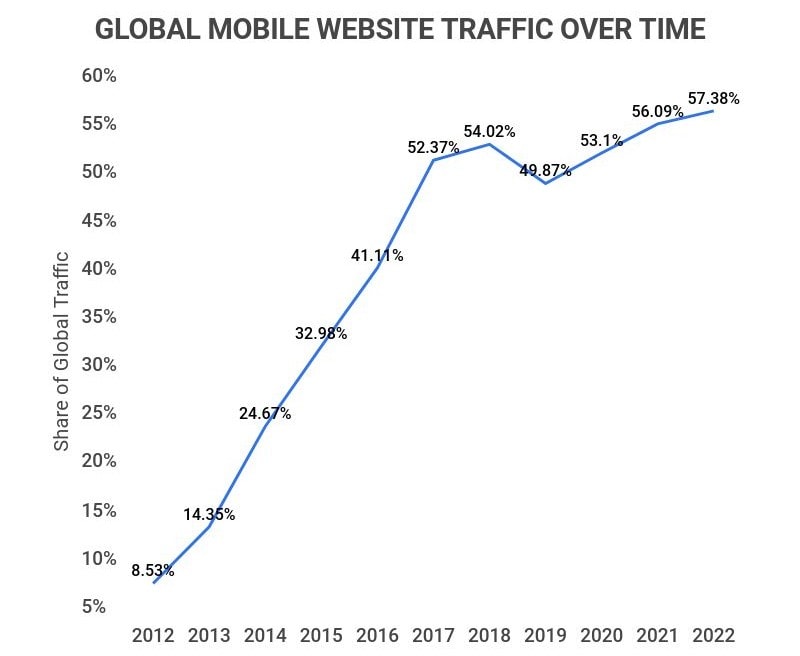The web development world has gone through an enormous amount of change in the last decade, and sadly many church websites seem to be living in the past. A church website stuck in 2006 is not going to fly anymore. With so many churches having beautiful and modern websites, you need to change with the times or be left behind.
In this post, we’ll cover everything you need to know about church websites in the modern day. Then, we’ll explore the top 7 signs that your church is stuck in the past. If you see any of those on your website, we encourage you to start changing them as soon as possible.
Ready to jump in? Let’s go.
Estimated reading time: 1 minute
Table of contents
Church Websites: Who Cares?

Before we get into our 7 signs that your church may be stuck in 2006, let’s go over church websites in general. We’ll cover an overview of church websites, why they’re important, and tips for maintaining your church website.
Why Church Websites Are Important
Church websites play a significant role in connecting with both current members and potential newcomers. They provide a virtual space where people can learn about your church’s mission, upcoming events, and service times. For those searching online, your church website is often their first impression. An easy-to-navigate site helps visitors quickly find information and understand what your church is all about.
Moreover, church websites can offer resources like sermon recordings, blog posts, and online giving options. This digital presence allows you to reach people who might not be able to attend in person, expanding your ministry’s impact.
Why Keeping Your Website Updated Matters
Regular updates are key to maintaining a functional and engaging church website. An outdated site can deter visitors and may even lead to frustration. Imagine a newcomer trying to find service times only to discover that the information is incorrect. This could lead to missed opportunities for engagement and a negative impression of your church.
Keeping your website updated ensures that information is current and relevant. This includes updating event calendars, contact information, and sermon content. Google Analytics, a tool that tracks website traffic, can help you understand what parts of your site are popular and where improvements are needed. By reviewing these logs, you can make data-driven decisions about what changes will benefit your visitors the most.
Tips for Maintaining Your Church Website
Here are some tips to help you maintain your church website and keep it up-to-date.
- Regular Updates: Check and update your website content regularly. Make sure that event details, sermon archives, and contact information are accurate and current. If you have new events or programs, be sure to create new pages or posts to share this information.
- Security Measures: Protect your website by using strong passwords and regularly changing them. This helps prevent unauthorized access to your site. Make sure that all user accounts have secure passwords and that you review who has access to your website’s backend.
- User Experience: Ensure that your website is easy to navigate. Test it on different devices and browsers to make sure it works well for everyone. A well-designed site enhances the user experience and keeps visitors coming back.
According to Zippia, 60% of website traffic worldwide comes from mobile devices. If your website doesn’t even work on phones, you got to get on that!

By following these simple guidelines, you can maintain an effective and welcoming online presence for your church. Regularly updating your site, safeguarding it with secure passwords, and monitoring its performance through tools like Google Analytics will help you connect better with your community and extend your outreach efforts.
Top 7 Signs You Need to Update Your Website

And that’s everything you need to know about church websites! Now, we want to get into the things you should look out for on your website to see if it might need an update.
Here are 7 signs that your church website might be two thousand and late.
1. Drop-down menus to get to the content
Back in 2005, we loved drop-down menus. They were a great way to squeeze in those extra pages without cluttering up the menu. They solved the problem of churches having 20 items in their main site navigation. Now they could nest pages under headings in the navigation and keep things well organized.
And that worked great until mobile browsing came along.
When people view websites on a mobile phone, there is no equivalent to hovering your mouse over a menu item. This made all those pages nested in a menu item you have to hover over impossible to reach.
While a modern site can have drop-down menus, all content must be accessible on a mobile device.
2. Separate page for everything
There was a time when we believed the more pages the better. Did a ministry meet at some point in the last 36 months? If so, then give them a page on the church website.
As this trend continued church websites got bigger. As they got bigger, the really important content like the service times, youth, and children’s ministries began to stand out less and less.
One thing we have learned over the years is that while all ministries are important, not all of them should have equal weight on the website.
We need to keep the main thing, the main thing. Ask yourself what a visitor to the site needs to see. If the content is not something that they need to see, then be ruthless. Just as a great sermon need not be long, and great website need not have 30 pages.
3. Flash
This used to be the go-to tool to make things move on a website. This drew attention and helped us tell better stories online. A site with a flash element was a great way communicate that your church was up with the times and a great place to visit this Sunday.
Today, that same flash that dominated the internet for a decade has gone the way of the cassette tape. While its capabilities are still unmatched, it is simply not compatible with too many mobile devices to be used.
Flash was officially discontinued in 2020, so none of those cool first impressions will even work anymore. It will just stand out to the visitor that this site hasn’t been updated in years. Make sure you get rid of these things as soon as possible.
4. Landing page before you get to the site

Up until this point, the items in this list served a purpose at one point. Making your visitors go to a landing page before they went to your site should never have been a thing.
The thought was if we had a page that was dedicated to only cool design elements with a link to enter the church website, we could make an even stronger first impression.
The reality was that most people would locate the “Enter Site” button before the page even loaded, and all you really accomplished was wasting a few seconds of their time.
People go to websites for information. The website’s primary job is to deliver information. It is important to engage people while they receive that information, but never make the mistake of thinking that people go to your site for the first time in order to be engaged, impressed or entertained.
5. Background music
Who among us has never been scared by music playing way too loud online when you least expect it. Background music on a church website has always been a bad idea.
We understand that you want to give people an idea of the kind of music they might experience if they visit your church this Sunday, but there has to be a better way. And there is.
When you can pull it off well, videos of your services are a great addition to any site. If you can’t do that with excellence, then let the photography tell the story of what to expect.
And under no circumstances should anything on your site auto-play. That is a sure way to annoy your visitors.
6. Church website is left justified
Any designer will tell you that should almost always be left justified. That is the truth.
But your entire website should not be on the left-hand side of the screen. That is something from the prehistoric web days. Even the Space Jam website is centered on the screen. (Yes, I am referring to the original Space Jam website, lying in state, the way it was when the movie was released).
While multiple lines of text should almost always be left justified, the body of the website should be in the middle of the screen.
7. Content is not fullscreen
We used to have a rule in designing websites where we would try to keep the entire site “above the fold”, a term borrowed from the newspaper industry. Rather than bury the lead, newspapers kept the most important parts of a story above the spot where the newspaper folded.
In web design that meant making everything visible to the user without having to scroll.
Today, scrolling has become much more acceptable due to the rise in mobile phone usage. People scroll for days on social media apps and that has become a much more intuitive way to browse a website.
The days of narrow columns in the middle of the screen are also over. Today with 1080p screens being the standard, a site should take advantage of all that real estate. Full-screen images and even video are the way to go.
How does your church website measure up?

Keeping your church website up to date is essential to ensure it remains relevant and useful in today’s fast-moving digital world. An outdated site, stuck in the design and technology of 2006, can deter visitors and hinder your outreach efforts.
By regularly updating your content, ensuring security with strong passwords, and using tools like Google Analytics to monitor visitor behavior, you keep your website fresh and engaging. This not only helps new visitors find the information they need but also makes your site a valuable resource for current members. A modern, well-maintained website reflects well on your church and enhances its ability to connect with the community. So, take the time to refresh your site regularly and stay current with digital trends. It’s a small effort that can have a big impact, helping your church remain vibrant and accessible in today’s online world.
Does your site break any of the rules above? Did we miss any signs that your site may be past its prime? Let us know in the comments below!
Not sure how your church website is working for you? Sign up for our totally free church website strategy review.





Comments 4
Its amazing how many websites are out of date! Most of our people have visited our website way before visiting our building. Its the new front door!
Author
You are dead on Cody. It is almost always a visitors first impression.
Ha ha! I can’t believe how many of these sites I still come across. There are still so many with background music that is so distracted or really poor in quality. I must say that I am seeing less flash now but still do from time to time. I did see a landing page before entering into the site with an explosion and chains breaking off not too long ago LOL.
Author
Flash + Landing Pages = Scaring away visitors. 🙂